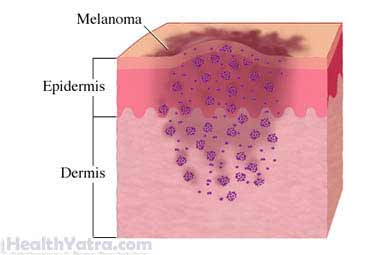تعريف
Melanoma removal is a surgery to remove cancer in skin tissue. The cancer is calledmelanoma.

أسباب هذا الإجراء
A melanoma removal is done to treat melanoma. For some it may be a cure for melanoma.
المضاعفات المحتملة
Complications are rare, but no procedure is completely free of risk. If you are planning to have a melanoma removal, your سيقوم الطبيب بمراجعة القائمة من المضاعفات المحتملة، والتي قد تشمل:
- العدوى
- نزيف
- تلف العصب
- تندب
- Incomplete removal of all cancerous الخلايا
- Recurrence or spread of cancer
Smoking may increase the risk of complications.
ما يمكن توقعه
قبل الإجراء
Depending on the stage of the disease, your doctor may do the following:
- Physical exam of skin
- Biopsy of any suspicious lesion
- تحاليل الدم
- Image tests such as Chest x-ray, CT scan, MRI, or PET scan
التخدير
Local anesthesia is often used to numb the area where the cancer is removed.General anesthesia may need to be used if the area is large. In this case, you will be asleep.
وصف الإجراء
Surgical removal of the cancerous cells is the primary treatment for melanoma. Types of surgery يشمل:
- Simple excision—The tumor is cut out, along with a small amount of normal skin at the edges. The wound is stitched back together. This نوع الجراحة may leave a scar.
- Wide excision—The tumor is cut out along with a larger area of normal skin. This will help make sure there are no cancer cells left behind.
- Amputation—A finger or toe may be removed if the cancer is on the digit.
- Lymph node dissection—Nearby lymph nodes may be removed if there is concern that the cancer spread. The removed lymph nodes will be sent to a lab for study.
The area may be closed with stitches. A larger area may need to be covered with a skin graft from another area of your body.
بعد العملية
In more advanced cases of melanoma, other treatments may be necessary. These include:
- العلاج الكيميائي
- علاج إشعاعي
- العلاج المناعي
كم من الوقت سيستغرق ؟
This depends on the extent of the melanoma and the type of surgery. Simple excision can take less than one hour.
هل سيكون هناك ألم؟
Anesthesia prevents pain during the procedure. You may have some pain around the wound during recovery. Medicine will help manage pain.
الرعاية ما بعد الجراحة
- Keep the surgical area clean, dry, and protected by bandages.
- If recommended by your doctor, apply a nonprescription antibiotic ointment to the wound before applying bandages.
- Take any medications as prescribed.
- Avoid vigorous يمارس according to your doctor’s recommendations.
- Return to have any stitches or staples removed when instructed.
- اسأل طبيبك حول, عندما هي آمنة للاستحمام, السباحة, أو نقع في الماء.
Talk to your doctor about appropriate ways to protect your skin against sun damage. These may include using sun block and wearing protective clothing. You will also need to have regular skin exams to look for the return of cancer cells. Do self-exams to look for any new or changing moles. Your doctor can show you how to do a self-exam.
استدعاء الطبيب
After arriving home, contact your doctor if any of the following occur:
- علامات الإصابة, بما في ذلك حمى وقشعريرة
- احمرار أو تورم أو ألم متزايد أو نزيف شديد أو أي إفرازات من موقع الشق
- Pain that you can’t control with the medications you’ve been given
- A new lump or discoloration in your skin
- A change such as color, bleeding, itching, or growth in an already-existing mole, either at the surgical site or in a new location
- Any other new or concerning symptoms
في حالة الطوارئ ، اتصل على المساعدة الطبية على الفور.
